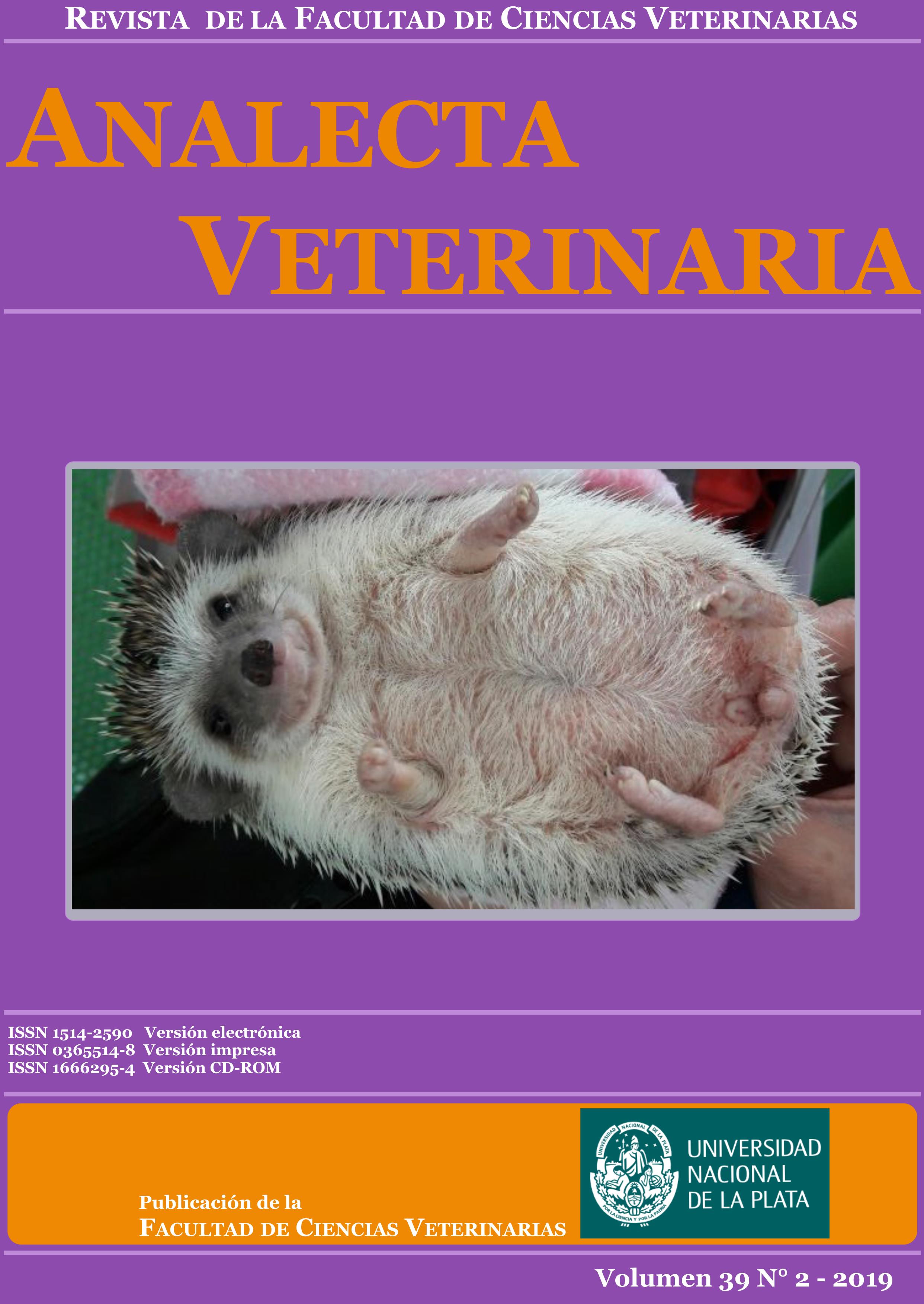Estudios histopatológicos y seguimiento clínico de sarcomas felinos asociados a sitios de inoculación
DOI:
https://doi.org/10.24215/15142590e039Palabras clave:
Histopatología, inmunohistoquímica, seguimiento clínico, sarcomas, sitios de inoculaciónResumen
Los sarcomas asociados a sitios de inoculación son neoplasias de origen mesenquimático que aparecen en las regiones corporales utilizadas rutinariamente para la aplicación de vacunas u otros inóculos. Con el objetivo de caracterizar estas neoplasias se seleccionaron 117 tumores diagnosticados como sarcomas posinoculación. Se realizaron estudios histopatológicos e inmunohistoquímicos que permitieron reclasificar los diferentes sarcomas hallados y establecer el porcentaje de células proliferantes. Además, se consideraron los datos demográficos y se realizaron encuestas a los médicos veterinarios para conocer la evolución de los pacientes. El diagnóstico más frecuente fue el de fibrosarcoma (87,18%). También, se encontraron, en menor proporción, otros tumores como: sarcomas pleomórficos (HFM), osteosarcomas extraesqueléticos y mixosarcomas. El grado histológico más frecuente fue el II y la mayoría presentó abundante inflamación. El promedio de células proliferantes alcanzó el 50,12%. La edad de los pacientes al momento del diagnóstico fue mayor que la informada por otros autores. Si bien los sarcomas asociados a sitios de inoculación en la República Argentina comparten características histopatológicas y clínicas con aquellos informados en otros países, existen diferencias vinculadas a la edad al momento del diagnóstico, a la presentación de las recidivas y al tiempo de sobrevida, entre otras características.
Referencias
Briscoe CM, Lipscomb TP, McKinney L. 1998. Pulmonary metastasis of a feline vaccinationsite fibrosarcoma. Journal of Veterinary Diagnostic Investigation. 10(1):79-82. doi: 10.1177/104063879801000114
Burton G, Mason KV. 1997. Do postvaccinal sarcomas occur in Australian cats? Australian Veterinary Journal. 75(2):102-8.
doi: 10.1111/j.17510813.1997.tb14167.x
Chang HW, Ho SY, Lo HF, Tu YC, Jeng CR, Liu CH, Wang FI, Pang VF. 2006. Vaccine associated Rhabdomyosarcoma with Spinal Epidural Invasion and Pulmonary Metastasis in a Cat. Veterinary Pathology. 43(1): 55-8. doi: 10.1354/vp.43155
Couto SS, Griffey SM, Duarte PC, Madewell BR. 2002. Feline vaccine associated fibrosarcoma: morphologic distinctions. Veterinary Pathology. 39(1):33-41. doi: 10.1354/vp.39133
Davidson EB, Gregory CR, Kass PH. 1997. Surgical excision of soft tissue fibrosarcomas in cats. Veterinary Surgery. 26(4): 265-9. doi: 10.1111/j.1532950X.1997.tb01497.x
Deim Z, Pálmai N, Cserni G. 2008. Feline vaccine associated fibrosarcoma induced by aluminium compound in two cats: short communication. Acta Veterinaria Hungarica. 56(1):111-6. doi: 10.1556/AVet.56.2008.1.11.
Dubielzig RR, Hawkins KL, Miller PE. 1993. Myofibroblastic sarcoma originating at the site of rabies vaccination in a cat. Journal of Veterinary Diagnostic Investigation. 5(4):637-8. doi: 10.1177/104063879300500427
Goldschmidt MH, Hendrick MJ. Tumors of the Skin and Soft Tissues. En: Meuten DJ 2002.Tumors in Domestic Animals. 4th Edition. Iowa, Ed Blackwell Publishing, pp. 45-117.
Hendrick MJ, Shofer FS, Goldschmidt MH, Haviland JC, Schelling SH, Engler SJ, Gliatto JM. 1994. Comparison of fibrosarcomas that developed at vaccination sites and at nonvaccination sites in cats: 239 cases (19911992). Journal of the American Veterinary Medical Association. 205(10):1425-9.
Hendrick MJ, Brooks JJ. 1994. Postvaccinal sarcomas in the cat: histology and immunohistochemistry. Veterinary Pathology. 31(1):126-9. doi: 10.1177/030098589403100121
Hendrick MJ, Goldschmidt MH. 1991. Do injection site reactions induce fibrosarcomas in cats? Journal of the American Veterinary Medical Association. 5(8): 968.
Hendrick MJ, Goldschmidt MH, ShoferFS, Wang YY, Somlyo AP. 1992. Postvaccinal sarcomas in the cat: epidemiology and electron probe microanalytical identification of aluminum. Cancer Research. 52(19):5391-4.
Hendrick MJ, Mahaffey EA, Moore FM, Vos JH, Walder EJ. Histological classification of mesenchymal tumors of skin and soft tissues of domestic animals. En: 1998. World Health Organization International Classification of Tumors in Domestic Animals. 2nd Edition, Washington DC, Ed. Armed Forces Institute of Pathology, pp. 15-60.
Hendrick MJ. 1999. Feline vaccineassociated sarcomas. Cancer Investigation. 17(4):273-7.
Hendrick, MJ. Mesenchymal Tumors of the Skin and Soft Tissues. En: Meuten DJ. 2017. Tumors in Domestic Animals, 5ta Edición, Iowa, Ed. Wiley Blackwell, pp. 142-75.
Hershey AE, Sorenmo KU, Hendrick MJ, Shofer FS, Vail DM. 2000. Prognosis for presumed feline vaccineassociated sarcoma after excision: 61 cases (19861996). Journal of the American Veterinary Medical Association. 216(1):58-61.
doi: 10.2460/javma.2000.216.58
Kass PH, Barnes WG Jr, Spangler WL, Chomel BB, Culbertson MR. 1993. Epidemiologic evidence for a causal relation between vaccination and fibrosarcoma tumorigenesis in cats. Journal of the American Veterinary Medical Association. 203(3):396-405.
MacEwen EG. Powers BE, Macy D, Withrow SJ. Soft Tissue Sarcomas. En: Withrow SJ, MacEwen EG. 2001. Small Animal Clinical Oncology. 3th Edition. Philadelphia, W.B. Ed Saunders Company, pp. 283-304.
Madewell BR, Griffey SM, McEntee MC, Leppert VJ, Munn RJ. 2001. Feline Vaccine associated Fibrosarcoma: An Ultrastructural Study of 20 tumors (1996-1999). Veterinary Pathology. 38(2): 196-202. doi: 10.1354/vp.382196
Martano M, Morello E, Buracco P. 2011. Feline injection site sarcoma: past, present and future perspectives. Veterinary Journal. 188(2):136-41. doi: 10.1016/j.tvjl.2010.04.025
Nieto A, Sánchez MA, Martínez E, Rollán E. 2003. Immunohistochemical expression of p53, Fibroblast Growth Factorb, and Transforming Growth Factorα in feline vaccineassociated sarcomas. Veterinary Pathology. 40(6):651-8. doi: 10.1354/vp.406651
O’Byrne KJ, Dalgleish AG. 2001. Chronic immune activation and inflammation as the cause of malignancy. British Journal of Cancer. 85(4):473-83. doi: 10.1054/bjoc.2001.1943
Poles GC, Clark DE, Mayo SW, Beierle EA, Goldfarb M, Gow KW, Goldin A, Doski JJ, Nuchtern JG, Vasudevan SA, Langer M. 2016. Colorectal carcinoma in pediatric patients: A comparison with adult tumors, treatment and outcomes from the National Cancer Database. Journal of pediatric surgery. 51(7):1061-6. doi: 10.1016/j.jpedsurg.2015.11.005
Risso MA, Risso P. Capítulo I. El teorema de Bayes. En: Risso MA, Risso P. 2017. Una Introducción a la Estadística Bayesiana: Uso de Lenguaje R y WinBUGS, 1raEdición, La Plata, Ed. Vuelta a casa, pp. 19-38.
Robledo Martín J. 2005. Diseño de muestreo (II). Nure Investigación. [En línea] Disponible en: http://www.nureinvestigacion.es/OJS/index.php/nure/article/viewFile/214/199Consultado: 02/04/2019
Rudmann DG, Van Alstine WG, Doddy F, Sandusky GE, Barkdull T, Janovitz EB. 1996.Pulmonary and mediastinal metastases of a vaccinationsite sarcoma in a cat. Veterinary Pathology. 33(4):466-9. doi: 10.1177/030098589603300422
Sandler I, Teeger M, Best S. 1997. Metastatic vaccine associated fibrosarcoma in a 10 year old cat. The Canadian Veterinary Journal. 38(6):374.
Sangüesa Nebot MJ, Cabanes Soriano F, Valverde Mordt C. 2007. Osteosarcoma extraesquelético. Caso clínico. Revista Española De Cirugía Osteoarticular. 42:88-92.
Santelices Iglesias OA, Wright C, Duchene AG, Risso MA, Risso P, Zanuzzi CN, Nishida F, Lavid A, Confente F, Díaz M, Portiansky EL, Gimeno EJ, Barbeito CG. 2018. Association between degree of anaplasia and degree of inflammation with the expression of Cox2 in feline injection site sarcomas. Journal of Comparative Pathology. 165:45-51. doi: 10.1016/j.jcpa.2018.09.002
Shaw SC, Kent MS, Gordon IK, Collins CJ, Greasby TA, Beckett LA, Hammond GM, Skorupski KA. 2009. Temporal changes in characteristics of injection site sarcomas in cats: 392 cases (1990-2006). Journal of the American Veterinary Medical Association. 234(3):376-80. doi: 10.2460/javma.234.3.376
Thompson KG, Pool RR. Tumors of Bones. En: Meuten DJ. 2002. Tumors in Domestic Animals, 4ta Edición, Iowa, Ed. Blackwell Publishing, pp. 245-317.
Thompson KG, Dittmer KE. Tumors of Bone. En: Meuten DJ. 2017. Tumors in Domestic Animals,5ta Edición, Iowa, Ed. Wiley Blackwell, pp. 356-424.
Wilcock B, Wilcock A, Bottoms K. 2012. Feline postvaccinal sarcoma: 20 years later. The Canadian veterinary journal. 53(4):430-4.
Woodward KN. 2011. Origins of Injection Site Sarcomas in Cats: The possible role of chronic inflammation a review. International Scholarly Research Network Veterinary Science. 2011:1-16. doi: 10.5402/2011/210982
Publicado
Número
Sección
Licencia
Los autores/as conservan los derechos de autor y ceden a la revista el derecho de la primera publicación, con el trabajo registrado con la licencia de atribución de Creative Commons, que permite a terceros utilizar lo publicado siempre que mencionen la autoría del trabajo y a la primera publicación en esta revista.

Analecta Veterinaria por Facultad de Ciencias Veterinarias se distribuye bajo una Licencia Creative Commons Atribución-NoComercial-SinDerivar 4.0 Internacional.




























